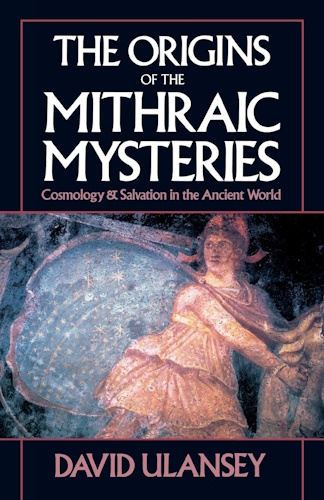

The Origins of the Mithraic Mysteries: Cosmology and Salvation in the Ancient World

In the centuries following the conquests of Alexander the Great the dramatic unification of the Mediterranean world created exceptionally fertile soil for the growth of new religions. Christianity, for example, was one of the innovative religious movements that arose during this time. However, Christianity had many competitors, and one of the most remarkable of these was the ancient Roman "mystery religion" of Mithraism.
Like the other "mystery cults" of antiquity, Mithraism kept its beliefs strictly secret, revealing them only to initiates. As a result, the cult's teachings were never written down. However, the Mithraists filled their temples with an enigmatic iconography, an abundance of which has been unearthed by archaeologists. Until now, all attempts to decipher this iconography have proven fruitless. Most experts have been content with a vague hypothesis that the iconography somehow derived from ancient Iranian religion.
In this groundbreaking work, David Ulansey offers a radically different theory. He argues that Mithraic iconography was actually an astronomical code, and that the cult began as a religious response to a startling scientific discovery. As his investigation proceeds, Ulansey penetrates step by step the mysteries concealed in Mithraic iconography, until finally he is able to reveal the central secret of the cult: a secret consisting of an ancient vision of the ultimate nature of the universe.
Brimming with the excitement of discovery--and reading like an intellectual detective story--Ulansey's compelling book will intrigue scholars and general readers alike.
Series: Cosmology and Salvation in the Ancient World
Paperback: 168 pages
Publisher: Oxford University Press; New Ed edition (March 28, 1991)
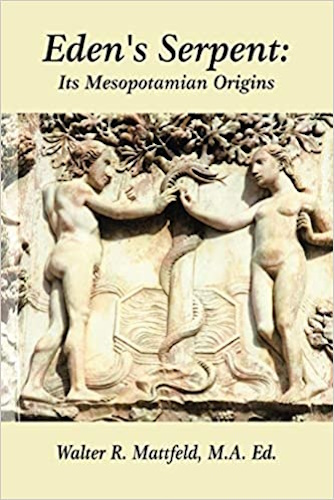

Eden's Serpent: Its Mesopotamian Origins

Several pre-biblical protagonists appearing in Mesopotamian myths are identified as being fused together and recast as the Garden of Eden's serpent.
Paperback: 189 pages
Publisher: lulu.com (October 24, 2010)
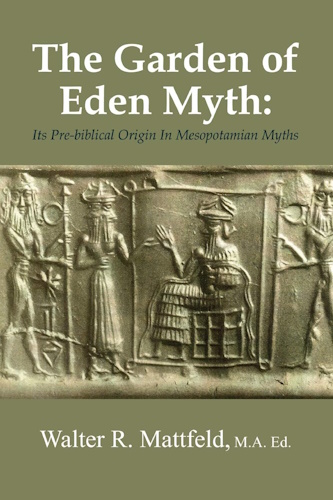

The Garden of Eden Myth: Its Pre-biblical Origin In Mesopotamian Myths

Scholarly proposals are presented for the pre-biblical origin in Mesopotamian myths of the Garden of Eden story. Some Liberal PhD scholars (1854-2010) embracing an Anthropological viewpoint have proposed that the Hebrews have recast earlier motifs appearing in Mesopotamian myths. Eden's garden is understood to be a recast of the gods' city-gardens in the Sumerian Edin, the floodplain of Lower Mesopotamia. It is understood that the Hebrews in the book of Genesis are refuting the Mesopotamian account of why Man was created and his relationship with his Creators (the gods and goddesses). They deny that Man is a sinner and rebel because he was made in the image of gods and goddesses who were themselves sinners and rebels, who made man to be their agricultural slave to grow and harvest their food and feed it to them in temple sacrifices thereby ending the need of the gods to toil for their food in the city-gardens of Edin in ancient Sumer.
Paperback: 184 pages
Publisher: Lulu.com (November 24, 2010)


Adam, Prometheus, and Faust--their stories were central to the formation of Western consciousness and continue to be timely cautionary tales in an age driven by information and technology. Here Theodore Ziolkowski explores how each myth represents a response on the part of ancient Hebrew, ancient Greek, and sixteenth-century Christian culture to the problem of knowledge, particularly humankind's powerful, perennial, and sometimes unethical desire for it. This book exposes for the first time the similarities underlying these myths as well as their origins in earlier trickster legends, and considers when and why they emerged in their respective societies. It then examines the variations through which the themes have been adapted by modern writers to express their own awareness of the sin of knowledge.
Each myth is shown to capture the anxiety of a society when faced with new knowledge that challenges traditional values. Ziolkowski's examples of recent appropriations of the myths are especially provocative. From Voltaire to the present, the Fall of Adam has provided an image for the emergence from childhood innocence into the consciousness of maturity. Prometheus, as the challenger of authority and the initiator of technological evil, yielded an ambivalent model for the socialist imagination of the German Democratic Republic. And finally, an America unsettled by its responsibility for the atomic bomb, and worrying that in its postwar prosperity it had betrayed its values, recognized in Faust the disturbing image of its soul.
Hardcover: 210 pages
Publisher: Princeton University Press (December 15, 2000)
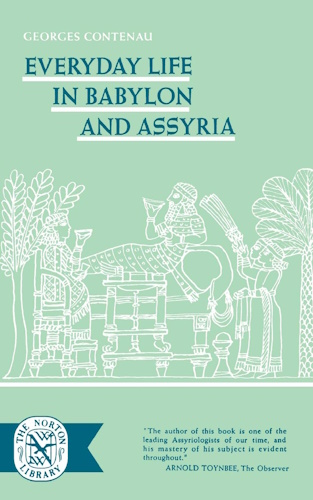

Everyday Life In Babylon and Assyria

“The author of this book is one of the leading Assyriologists of our time, and his mastery of his subject is evident throughout.” ―Arnold Toynbee, The Observer
M. Contenau has chosen to survey the period between 700 and 530 B. C. out of the whole 2600 years of Mesopotamian civilization for two reasons: it is the most representative and more is known about it than any other time in the history of this culture. During these years the Near East was dominated first by the Assyrians and then by the Babylonians, who were to be subdued by the Persians. The everyday life of these people has been reconstructed from a wealth of evidence, both written records of many kinds preserved on clay tablets and the evidence of monuments excavated at such sites as Khorsabad and Nineveh, Nimrud and Asher, Babylon and Susa. “Perhaps the main impression. . .that we carry away from this survey is that the life of an inhabitant of Babylonia in about 600 B. C. must have closely resembled that of any inhabitant of the Orient up to about fifty years ago,” writes M. Contenau. This account of Mesopotamian life is, therefore, pertinent not only to an understanding of the age of Assyria and Babylonia but also to all the civilizations that have succeeded it in that part of the world.
Paperback: 368 pages
Publisher: W. W. Norton & Company (March 17, 1966)
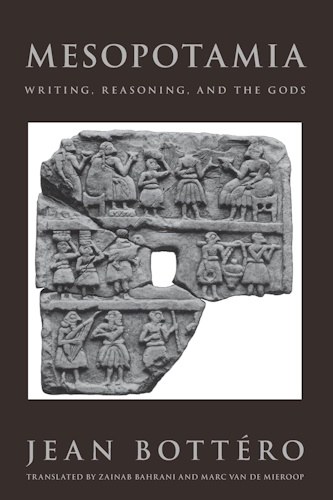

Mesopotamia: Writing, Reasoning, and the Gods

Our ancestors, the Mesopotamians, invented writing and with it a new way of looking at the world. In this collection of essays, the French scholar Jean Bottero attempts to go back to the moment which marks the very beginning of history. To give the reader some sense of how Mesopotamian civilization has been mediated and interpreted in its transmission through time, Bottero begins with an account of Assyriology, the discipline devoted to the ancient culture. This transmission, compounded with countless discoveries, would not have been possible without the surprising decipherment of the cuneiform writing system. Bottero also focuses on divination in the ancient world, contending that certain modes of worship in Mesopotamia, in their application of causality and proof, prefigure the "scientific mind."
Paperback: 311 pages
Publisher: University of Chicago Press; Reprint edition (June 15, 1995)
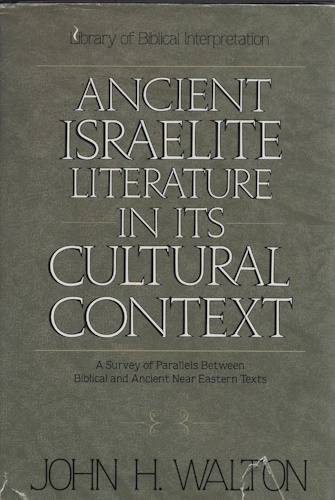

Ancient Israelite Literature in Its Cultural Context: A Survey of Parallels Between Biblical and Ancient Near Eastern Texts

From the Back Cover
This unique book surveys within the various literary genres the parallels between the Bible and the literature of the ancient Near East. Each section begins with a survey of the available ancient literature, continues with a discussion of the literature, and concludes with a discussion of cases of alleged borrowing. The genres covered are - cosmology - laws - historical literature - wisdom literature - apocalyptic literature - personal archives and epics - covenants and treaties - hymns, prayers, and incantations - prophetic literature --This text refers to an out of print or unavailable edition of this title.
About the Author
John H. Walton (PhD, Hebrew Union College) is professor of Old Testament at Wheaton College Graduate School. He is the author or coauthor of several books, including Chronological and Background Charts of the Old Testament; Ancient Israelite Literature in Its Cultural Context; Covenant: God's Purpose, God's Plan; The IVP Bible Background Commentary: Old Testament; and A Survey of the Old Testament. --This text refers to an out of print or unavailable edition of this title.
Series: Clarion Classics
Hardcover: 256 pages
Publisher: Regency Reference Library (November 1, 1989)
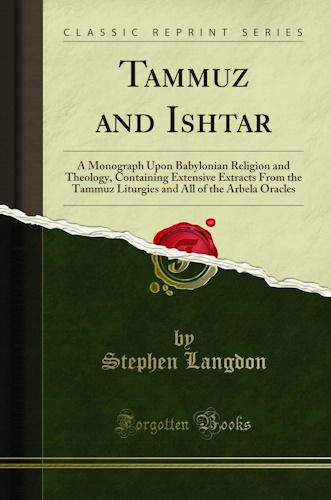

Tammuz and Ishtar: A Monograph Upon Babylonian Religion and Theology, Containing Extensive Extracts From the Tammuz Liturgies and All of the Arbela Oracles (Classic Reprint)

Excerpt from Tammuz and Ishtar: A Monograph Upon Babylonian Religion and Theology, Containing Extensive Extracts From the Tammuz Liturgies and All of the Arbela Oracles
About the Publisher
Forgotten Books publishes hundreds of thousands of rare and classic books. Find more at www.forgottenbooks.com
This book is a reproduction of an important historical work. Forgotten Books uses state-of-the-art technology to digitally reconstruct the work, preserving the original format whilst repairing imperfections present in the aged copy. In rare cases, an imperfection in the original, such as a blemish or missing page, may be replicated in our edition. We do, however, repair the vast majority of imperfections successfully; any imperfections that remain are intentionally left to preserve the state of such historical works.
Paperback: 214 pages
Publisher: Forgotten Books (April 19, 2018)
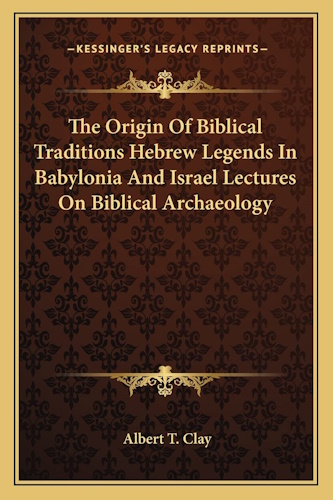

The Origin Of Biblical Traditions Hebrew Legends In Babylonia And Israel Lectures On Biblical Archaeology

This scarce antiquarian book is a facsimile reprint of the original. Due to its age, it may contain imperfections such as marks, notations, marginalia and flawed pages. Because we believe this work is culturally important, we have made it available as part of our commitment for protecting, preserving, and promoting the world's literature in affordable, high quality, modern editions that are true to the original work.
Paperback: 230 pages
Publisher: Kessinger Publishing, LLC (September 10, 2010)
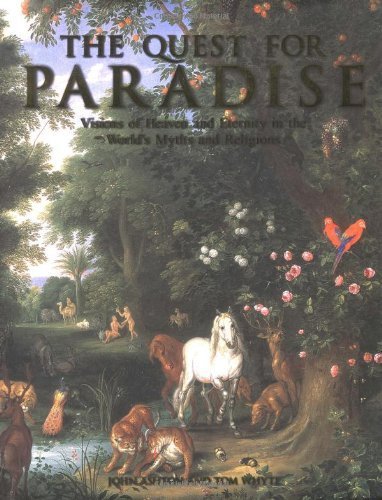

The Quest For Paradise: Visions of Heaven and Eternity in the World's Myths and Religions

In every culture, in every epoch, human beings have yearned for heaven -- the dwelling place of the gods, mirror of our hopes and desires. Now, in The Quest for Paradise, renowned scholar John Ashton and his colleague Tom Whyte offer an intriguing look at how we have thought of and envisioned heaven and the afterlife, from the ancient cultures of Egypt, Greece, and Rome, to the Christians, Jews, Buddhists, Hindus, and Muslims, as well as the indigenous peoples of the Americas, Australia, and Africa.
Lavishly illustrated with extensive depictions of heaven in art from around the world, and drawing on scriptures, myths, epics, poems, novels, philosophy, and other writings from many cultures, The Quest for Paradise illuminates the vast spectrum of beliefs about the world beyond. The book also explores the concept of utopia, or paradise on earth, from the perspective of such diverse thinkers as H.G. Wells, D.H. Lawrence, Margaret Mead, and Aldous Huxley.
Ashton and Whyte present a fascinating array of ancient and modern views of heaven. Included are extraordinary inhabitants and geographical features, representing scenes from works such as The Odyssey, the Bible, the Quran, and the Sukhavativyuha Sutras, and from the works of writers such as Hesiod, Ovid, Virgil, Dante, Milton, and Yeats, highlighting both the diversity and the universality of reflection on heaven.
Hardcover: 160 pages
Publisher: HarperOne; 1st edition (October 23, 2001)
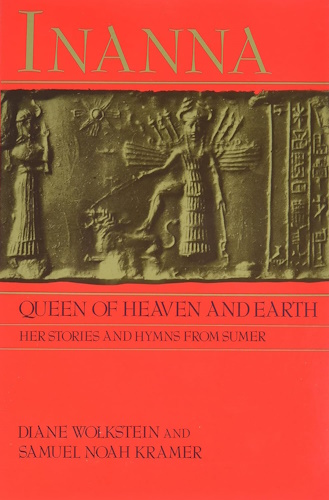

Inanna, Queen of Heaven and Earth: Her Stories and Hymns from Sumer

"This is an admirable translation, a great masterpiece of universal literature."--Mircea Eliade"A splendid mutual accomplishment and a great gift ot mythology...."Inanna "is a book to be cherished."--P.L. Travers"In the myth of Inanna, Wolkstein and Kramer give us back the totality of woman, the ruler-wife-lover-redeemer, whom all worshiped and from whom all life flowed. It is a thrilling rediscovery."--Olivier Bernier"Wolkstein has been able to convey in English the rich metaphor, the erotic fullness, and the ritual pacing of these ancient stories....Taken together with the illustrations, historical discussions, and textual commentaries, this book is worth a tower of scholarly tomes....Such a feat is remarkable and rare."--Barre Toelken, Director of Folklore and Ethnic Studies, University of Oregon"I felt shivers of recognition reading these ancient lines that proclaim Inanna's discovery of her prowess....Kramer and Wolkstein make us love their awesome goddess whose stormy complexities have been concealed in cuneiform tablets for thousands of years."--Nor Hall
About the Author
Diane Wolkstein has been teaching, performing, and writing for over thirty-five years. She is the author of numerous award-winning books of folklore, including The Magic Orange Tree, and Other Haitian Folktales and Inanna, Queen of Heaven and Earth: Her Stories and Hymns from Sumer. Known for her meticulous research as well as her great range as a performer, Ms. Wolkstein traveled to Australia three times while preparing this story. She gives workshops on storytelling worldwide and lives in New York City.
In Her Own Words...
"I love stories. They give me strength, Inspiration, courage, and great delight. For thirty years I've told stories at the statue of Hans Christian Andersen in Central Park. I love watching the eyes of my audience light up as they enter stories. Stories let us explore the farthest places in the universe and the deepest recesses of the human heart. They present possibilities. They let us try out different emotions and characters. Stories are treasures which last forever.
"I also enjoy gardening, dancing, swimming, painting, and creating stories with music. My daughter, Rachel Zucker, is a poet, photographer, and the mother of a little boy named Moses."
Paperback: 227 pages
Publisher: Harper Perennial; 1st edition (August 3, 1983)
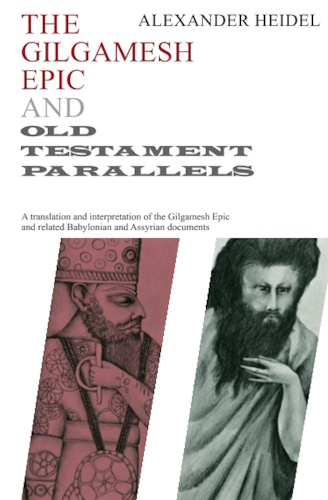

The Gilgamesh Epic and Old Testament Parallels (Phoenix Books)

Cuneiform records made some three thousand years ago are the basis for this essay on the ideas of death and the afterlife and the story of the flood which were current among the ancient peoples of the Tigro-Euphrates Valley. With the same careful scholarship shown in his previous volume, The Babylonian Genesis, Heidel interprets the famous Gilgamesh Epic and other related Babylonian and Assyrian documents. He compares them with corresponding portions of the Old Testament in order to determine the inherent historical relationship of Hebrew and Mesopotamian ideas.
About the Author
Alexander Heidel was at the time of his death in 1955 on the research staff of the Oriental Institute, University of Chicago.
Paperback: 269 pages
Publisher: University of Chicago Press; 2nd edition (September 15, 1963)
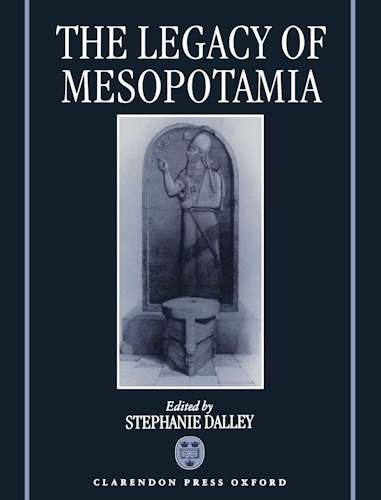

The Legacy of Mesopotamia (Legacy Series)

This collection explores the spread of culture through literacy from Mesopotamia into Egypt, Palestine and Greece after a system of writing was developed. By gathering evidence from a vast range of material and literary sources from 3000 BC onwards, threads of influence and continuity are traced into the Middle Ages. The effect of recent rediscovery on European art is also explored.
About the Author
Stephanie Dalley is at Somervil+C2768le College, Oxford.
Series: Legacy Series
Paperback: 246 pages
Publisher: Oxford University Press (February 2, 2006)
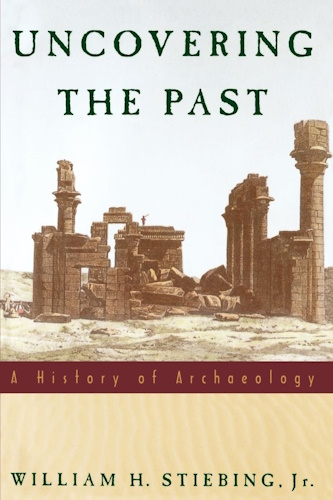

Uncovering the Past: A History of Archaeology

When one hears the words "archaeology" or "archaeologist," often what comes to mind is an image of a romantic figure: Indiana Jones exploring exotic places in search of treasure and adventure. Indeed, novels, movies, and many popular accounts of archaeological discoveries have made this concept widespread. Tales of abandoned cities, ruined temples, primeval monuments, or mysterious ancient tombs tend to kindle the urge for adventure, exploration, or treasure hunting that seems to lie beneath the surface of even the most timid and conventional individuals. Today, however, archaeologists seek knowledge rather than objects that are intrinsically valuable. Their ultimate goal is to sweep aside the mists in which time has enveloped the past, helping us to understand vanished peoples and cultures.
In Uncovering the Past, William H. Stiebing, Jr. offers an absorbing nontechnical history of archaeology, tracing the study of ancient material culture from its beginnings in the Renaissance through its development into the sophisticated modern discipline we know today. The first study to focus on archaeology as a discipline, Stiebing has organized this concise history into the four stages of archaeological development. The first two stages (1450-1860 and 1860-1925), known as the "heroic age," focus on the exploits of colorful, dynamic excavators who have made their mark on history and our imaginations. We read accounts of Giovanni Belzoni and the removal of the seven-ton colossus of Ramesses II, which was dragged by wooden platform and transported by boat from Egypt to London; we witness the clergyman John Peters's skirmish with Arab tribesmen, who surrounded his excavation site and finally pillaged and burned his camp; and Heinrich Schliemann's quest to prove the authenticity of Homer's Iliad by searching for ancient Troy along the Turkish coast. And we watch as archaeology comes of age as an academic discipline, employing stratigraphical excavation techniques, typographical sequence dating, and stratigraphically based pottery chronology--laying the foundation for universal archaeological activity. The third phase (1925-1960) marked the era of "Modern Archaeology," a time when, using the now generally accepted stratigraphical method of excavation, scholars were able to synthesize data to define individual cultures and trace their development through time. This period saw a greater use of scientific instruments and procedures to locate, date, and interpret remains, such as aerial photography, metal detectors, and most importantly, carbon-14 dating and tree-ring chronology. Lastly, Stiebing discusses the fourth phase of development (1960-present) which introduced a greater desire and need for a more complete understanding of ancient cultures, including their ecology, and attempts to explain why certain cultural phenomena occurred. He goes on to examine the greater emphasis on a cultural revolutionary approach, coupled with technological advances in robotics and computers over the last decade and a half and their commonplace role in modern archaeology.
With over eighty photographs, illustrations, and maps, this vivid history is an outstanding introduction to the intriguing field of archaeology, chronicling the development of this former pastime of dilettantes into a rigorous science.
About the Author
William H. Stiebing, Jr. is Professor of History at the University of New Orleans and author of the critically acclaimed Out of the Desert?.
Paperback: 320 pages
Publisher: Oxford University Press; Revised ed. edition (December 8, 1994)


Julian's Against the Galileans

Against the Galilaeans, meaning Christians, was a Greek polemical essay written by the Roman Emperor Flavius Claudius Julianus, commonly known as Julian the Apostate, during his short reign (361–363). Despite having been originally written in Greek, it is better known under its Latin name, probably due to its extensive reference in the polemical response Contra Julianum by Cyril of Alexandria. As emperor, Julian had tried to stop the growing influence of Christianity in the Roman Empire, and had encouraged support for the original pagan imperial cults and ethnic religions of the Empire. In this essay Julian's described what he considered to be the mistakes and dangers of the Christian faith, and he attempted to throw an unflattering light on ongoing disputes inside the Christian Church. Julian portrayed Christians as apostates from Judaism, which the Emperor considered to be a very old and established religion that should be fully accepted. After Julian's death in battle in 363, the essay was anathematized, and even the text was lost. We only know of Julian's arguments second-hand, through texts written by Christian authors who sought to refute Julian. Julian first criticizes the practice of the Galileans of denying the existence of the gods, and their practice, taken from the Greeks, of being lazy and superstitious. Julian claims that men inherently know of the existence of God without being taught of it and that all men have an inherent belief that the gods reside in the heavens and observe what occurs in the world. Further, all men, from looking at the stable nature of the heavenly bodies, have come to believe that the gods are eternal and unchanging. Julian goes on to discuss the creation myths of the Greeks and the Jews, citing the account of the Book of Genesis. He ridicules the idea of literally interpreting the Jewish account, claiming that it is not only logically impossible, he asks how the serpent was able to speak a human language but that is also blasphemous and insulting to God. A true God, he says, would not have withheld the knowledge of good and evil from men or have been jealous of men eating from the tree of life and living forever. Indeed, this behavior shows God to be evil and the serpent, giving man the enormously valuable gift of differentiating good and evil, to be good. Therefore, it must have a deeper meaning.
Paperback: 51 pages
Publisher: Independently published (June 29, 2017)
![]()
![]()